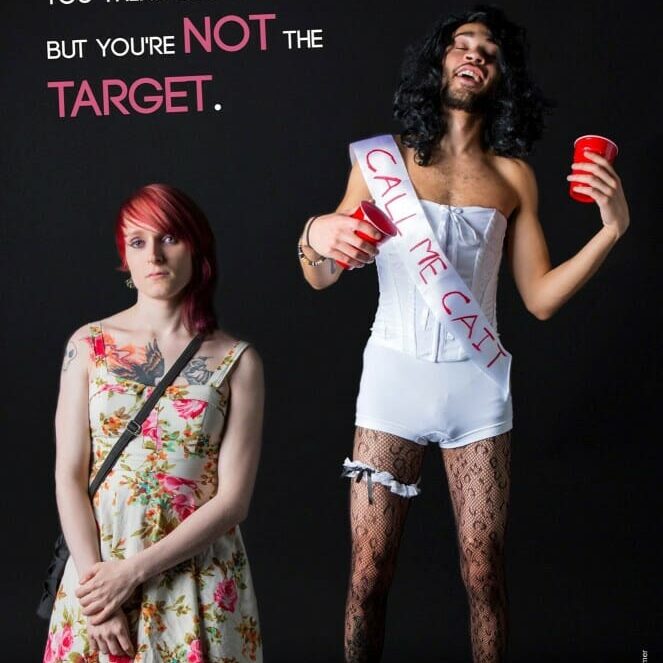
You think it’s harmless, but you’re not the target
DalOUT on Halloween Costumes
“On October 31st in 2012, I attended my Dal classes dressed in costume for Halloween. That year I was Ja’mie King from the television show Summer Heights High. This involved me wearing a green plaid shirt-dress, knee high socks, women’s business wedges, and a brunette wig. In the afternoon, I attended my Abnormal Psychology class, where we learned about mental health ‘disorders’ and diagnoses. When my professor noticed my outfit during class, she offhandedly remarked that I should come back dressed like that for the class on ‘gender identity disorder’.” (Gender identity disorder is an old diagnosis given to transgender people, and has recently been renamed ‘gender dysphoria’.)
“After my professor’s remark, I was embarrassed, taken aback, and pissed off. I waited until class was over and quietly let her know that what she did was wrong and how it could have offended people. She was very willing to listen and learn, and she apologized publicly during the next class.”
We begin with this personal story because it illustrates that while Halloween costumes can be fun for many people, they can also be complicated or even very negative for transgender people. In one sense, wearing a costume that expresses aspects of your identity can be validating. In another sense, costumes may allow the wearer or those around them to trivialize or make a joke out of being transgender, even unintentionally.
Regardless of the wearer’s intentions, a costume that targets or mocks a specific group of marginalized people the wearer does not belong to is harmful and disrespectful. Our intentions do not take precedence over the very real hurt of others.
Fast-forward to 2015. DalOUT shared two posters to its Facebook page about gender identity in relation to problematic Halloween costumes. One reads, “My identity is not a costume. You think it’s harmless, but you’re not the target.” The other reads, “Our gender identity is not a costume. This is not who I am, and this is not okay.” These posters received significant attention on Facebook and beyond, were shared over 700 times within a few days, and generated a lot of conversation and debate.
These posters were created alongside a movement against cultural appropriation during Halloween. Cultural appropriation is the act of adopting and trivializing elements of other cultures in costume, normally leading to offensive racial stereotypes.
With the creation of Caitlyn Jenner Halloween costumes this year, the concept of transphobic Halloween costumes began to receive widespread attention. Halloween costumes often play up stereotypes and laugh at misconceptions society has about groups of people. This humour can be harmless when directed at cartoon characters, movie stars, professions (i.e. police officers or doctors), or spooky creatures.
But Halloween costumes involving gender become much less funny considering the reality of transphobia and violence that trans people, especially trans women, face. Trans women are murdered at a rate much higher than any other group within the LGBTQ+ community, with trans women of colour facing the most discrimination and violence.
When a cisgender (the opposite of transgender) man dresses in stereotypically women’s clothing as a joke on Halloween, it supports the misconception that transgender women are just “men in dresses.” In other words, a costume like this spreads the idea that a man wearing a dress is inherently funny, and that transgender people are not to be taken seriously in their gender presentation and identity.
“Performing and dressing in drag was one of the first ways I came into my identity as a transgender person, and because of that I think that it still is an important aspect of LGBTQ+ culture. Dressing in drag or in costume lets people explore and express their gender identity and can allow other people to see aspects of someone’s gender that may go unnoticed from day to day.
This being said, drag isn’t always positive or beneficial for the LGBTQ+ community – at times it can reinforce misogyny, toxic masculinity, and the gender binary, and it can be a terrifying source of gendered policing.
I performed in drag a handful of times, but now the connotations associated with being a ‘drag queen’ lurk over me in different aspects of my life. I try hard to separate myself from it because I view myself as a trans feminine person. I am not a man in drag; I am not a man at all.”
This Halloween, when you’re coming up with costume ideas, think about who the costume may impact or disrespect in ways outside of your intended or desired effect. Often, the things we do without a second thought carry much larger consequences for the safety, comfort, and belonging of others.
Halloween can be a fun-filled occasion for many people, whether they are transgender or cisgender. But keep in mind that transgender and gender-questioning people deserve so much more than having one day a year to explore their gender identity and expression without fear of stigma or harassment.
What can you do to be a safer person for transgender people on Halloween and on every other day of the year? If you aren’t sure, there are many on-campus resources that can answer your questions, including DalOUT’s drop-in centre, found in the lower level of the SUB!







